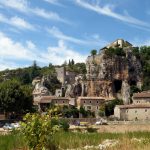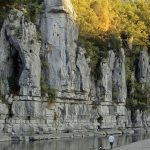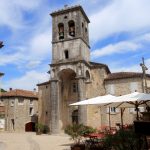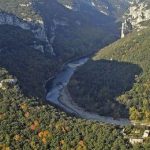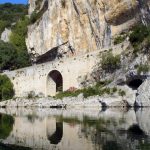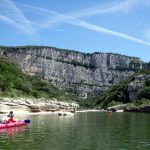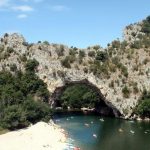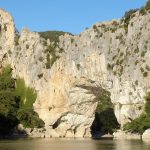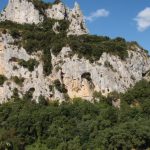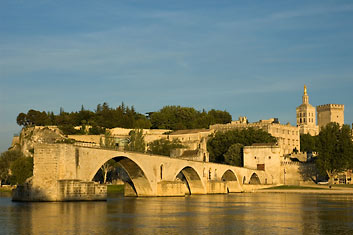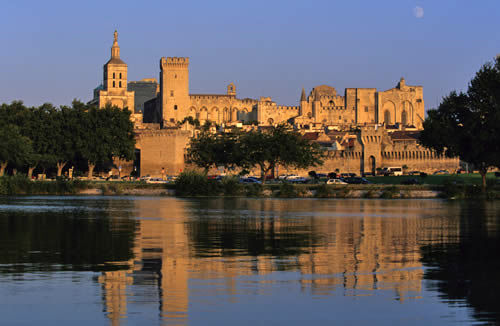The Ardeche river and its surrounding area is a beautiful region of Southern France to explore with a number of great places to visit.
The region has an amazing landscape filled with medieval villages perched on cliff edges or nestled down by the water, many of which are classified as ‘villages with outstanding character’ (17 in total) and some are listed as the most beautiful villages in France. Vogüé (for example) was recently voted 5th favourite village in France on a TV poll in 2016.
Please scroll down for more details about places to visit in the local area. For details about local attractions and activities available, please see the following links.
Places to visit in the Local Area...
Gorges de l'Ardeche
The Gorges de l’Ardeche starts just after the Pont d’Arc which is seen as the gateway into the gorge. It is 24km long and winds through wooded slopes with limestone cliffs towering up to 1000ft above on each side. The only way to see this properly (other than from the view points above) is to travel through the Gorge on foot or by canoe/kayak. Our two-day river trips cover 32km which includes the top 8km (3 rapids and the Pont d’Arc) and the entire 24km gorge section (with about 26 rapids).
Classified as a Nature Reserve back in 1980 the Gorges de l’Ardeche are filled with more than a thousand different species of plant and animals including loads of fish (trout, carp, catfish, apron fish etc); wild goats; cicardas; lizards; bonneli’s Eagles; wild boar; black kites; genets; beavers; otters and even a few Egyptian vultures!
To wild camp within the Gorges de l’Ardeche is strictly prohibited although there are two managed sites (Bivouac de Gaud and Bivouac de Gournier) which are right in the heart of the nature reserve. Although basic, these sites have access to toilets/showers, drinking water, rubbish bins and have pre-built BBQ’s on site for people to use – they even provide the charcoal for us! Other than this, the sites are open fields where you can pitch your tents for the evening.
The Ardeche Gorge is a very popular location and as such, the river can get busy during weekends and during July and August. Therefore, for the best way to experience this magical place, we recommend coming in April, May, June or September when the river is much quieter. However, with a guided river trip we will still ensure you get the most from your trip in July/August by timing our trip to avoid most crowds.
Le Pont d'Arc
This elegant and majestic arch has been created in the limestone rock over thousands of years and has become the emblem of the entire region. This famous landmark is the largest natural arch in Europe and stands an impressive 66m high (215ft) and has a span of 34m (110ft).
Before the river managed to break its way through, the Ardèche ran around the side along the Combe d’Arc where the road now is. It is along this old river bed, half way up the cliff face, that 3 local cavers discovered the Chauvet cave in December 1994. It contains around 420 images of animals dating back between 30,000-36,0000 years old. In order to protect the real cave and these important discoveries a full size replica (The Caverne du Pont d’Arc) was built in 2015 which enables tourists to experience the magnitude of this U.N.E.S.C.O World Heritage Site.
Since the Ardèche was often a difficult river to ford, the bridge was a strategic route over which the Protestants and Catholics fought. After a battle, the victors would often invite their enemies to jump into the river, and pushed them if they seemed too hesitant. Since Louis 13th destroyed the cornice, it has become too dangerous to cross.
Higher up on the left hand side is the prominent rock of Charlemagne by which a family of Bonelli Eagles nest. This is visible from the hotel and offers you a great opportunity to see these protected birds. The rock is named after the Great King because it resembles a famous image of King Charlemagne on horseback. Because of this the rapid which precedes the mighty Pont d’Arc is also known as ‘Charlemagne’.
Vallon Pont d'Arc
This small farming town becomes a bustling tourist resort in the spring. Sat on the edge of the Gorges de l’Ardèche, Vallon enjoys a mild Mediterranean climate. With water, sun and nature all around, Vallon Pont d’Arc is the perfect centre for many outdoor activities. It is also steeped in history and surrounded by the most beautiful landscape.
There are a number of shops in the town centre along with a selection of cafes and restaurants. There are also regular markets throughout April-September on Thursday mornings with a night market on Tuesday evening during July and August.
Vallon Pont d’Arc became a Protestant stronghold during the religious wars and in 1621 the town was placed under siege. In 1628, King Louis XIIIth ordered that the Castle and the fortifications were destroyed and a new Catholic Lord was appointed. In 1629, the King gave this new Lord of Vallon the possessions of his subjects as compensation for the destruction of his castle. However, in order to get their possessions back, the inhabitants of Vallon built the new Castle of their Lord not where requested but instead built it in the centre of the village itself. In 1846 the castle was sold to the townsfolk and was converted into the town hall. It still contains the tapestries of Aubusson which are listed as a historical monument, illustrating the first Crusaders in the Holy land under the leadership of Lord Godefroi de Bouillon and they can be seen during the Town Hall’s opening hours.
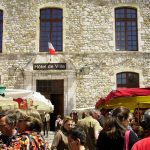
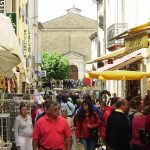
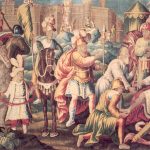



Vogüé
(pronounced vog-oo-ay) Listed as a village of character and 5th place in the favourite village in France in a TV poll in 2016, this medieval village is built like an amphitheatre in the curve of the cliff and is dominated by the 16th Century castle which replaced the earlier 12th century primitive fortress. The narrow streets with vaulted arches can be reached by a beautiful avenue of Chestnut trees planted in 1735. The view of the village stretched out along the Ardeche river is one of the most famous and picturesque images of the southern Ardeche.
The lords of Vogüé! This family was undoubtedly the most powerful in the Vivarais (an old department in France that covers parts of Provence, Ardeche, Languedoc and Gard). They were one of the greatest families in the Languedoc, if not in the entire kingdom. They were honoured with the title of Baron of the Languedoc and Governor of Provence. In the nineteenth century, they included two members of the French Academy: Charles-Jean Melchior, archaeologist and diplomat and Eugène Melchior who introduced the great Russian authors to the French intelligentsia.
Henri Charrière, probably better known by his nickname ‘Papillon’, was born November 16, 1906 in Saint-Etienne-de-Lugdarès in the Ardèche, he is buried a few kilometres south of Vogue in Lanas where his mother was a school mistress.
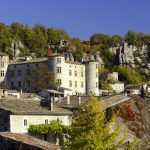
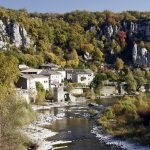
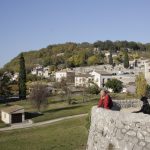
Balazuc
This is another Ardeche ‘village of character’ and is also listed as one of the ‘most beautiful villages of France’. Built on the edge of the cliff, this picture perfect village offers cobbled streets, narrow alleys and arches seemingly carved straight from the rock.
There is a 16th Century Chateau and a 10th Century Keep with no door on ground level. Prison or for defense? The mystery remains. At the bottom of this village there is a Romanesque church with a three arched bell tower which can be reached from the outside. The apse is heightened to form a defensive tower since Balazuc was an isolated Catholic outpost in a predominantly Protestant lower Ardèche.
Although officially classified as a medieval village, not everything in Balazuc dates from before the 16th Century. There is a 19th century bridge and since the 1960’s much of the village, which had been damaged during the Great War, was lovingly restored using traditional methods and with respect to the historical architecture.
Balazuc was the site of the discovery of a Neanderthal man from over 50,000 yrs ago found in a cave on the other side of the river and is also home to the Ardeche Museum of Natural History.
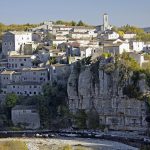
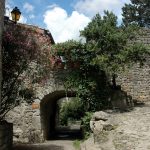
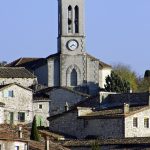



Labeaume
Labeaume is a small village on the bank of the river of the same name, surrounded by cliffs and rocks like majestic, twisted and ruined walls. It is extremely attractive and has been given the ‘village of character’ classification.
The church and town hall are surrounded by old houses and narrow alleys. Lower down in the main square, the Place du Sablas, on the edge of the river is the welcoming shade of centuries old plane trees. There is a good sized beach and section of calm river where you can swim and play (good for the whole family) and there are cafes, a few shops and restaurants to enjoy. This should be a definite on your list of places to visit.
The Labeaume Music Festival draws yet more visitors to these fascinating places with a programme of superb classical music. Every year a musical festival is held here, one of the most remarkable events in Southern Ardèche. In July and August, Labeaume becomes a village completely dedicated to classical music. Famous and talented artists meet in the evening in the church, the gorges, the bridge or the disused quarries. Nature becomes a grandiose concert hall creating a unique, friendly atmosphere.
